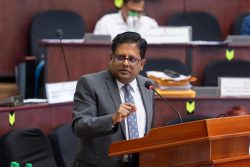The decision to use this column to address the GRIF-funded US$5 million LCDS Micro and Small Enterprise Development and Building Alternative Livelihoods for Vulnerable groups (MSE) Project was taken two evenings ago and only after the Editor of the Stabroek Business had told the writer that this week’s issue of the newspaper would contain some revelations on the project.
Thank God for the acronym! The title of the project is more than a trifle ridiculous.
There are things to be said about the MSE Project and while they cannot all be said in this column at least some of them can be raised now.
First, having regard to the fact that funding small business development in Guyana has always been an issue it took far too long (a year after the project was officially launched) to have it up and running. As far as the timing is concerned the mind boggles. A great many small business owners and aspirants had to wait for a long time to get their hands on what in some instances is not a great deal of money.
A project like this could have its challenges and it would be interesting to see what the end of the next two years brings. Will the targeted number of jobs (1,200) expected to result from the various investments in the various small businesses materialise? Of course, if all goes well all of the various investments in training ought to pay some dividends and in that respect another important statistic down the road would be the number of persons who, having received the $300,000 grants (as against the bank larger loans) would have been able to move to the next level (or close enough to that level) over a period of two years or so.
Some things, of course, haven’t changed. Two of them come to mind. The first is the general cloud of suspicion (whether all of it is justified is another matter) that usually settles very quickly over government administered projects in cases where funding is concerned.
What has also not changed is the traditional attitude of commercial banks to business projects that are on the floor, so to speak. In this particular instance two commercial banks are on board under conditions that provide them with a considerable measure of protection,
To take the issue of ensuring transparency first it is comforting to see that the project will benefit from the transparency-related best practices of the Inter-American Development Bank. Experiences elsewhere in the world have demonstrated that straightforward embezzlement aside, corruption can occur through the misdirection of finances, nepotism being one of the commonest mechanisms for perpetrating corruption. We need, for example, to guard against the granting of family favours or requests by high officials for corners to be cut. Apart from contributing to the stigmatization of the project the misallocation of funds can create a situation in which deserving (smaller) enterprises do not benefit as they should.
What the commercial banks should be aiming for is working with small projects—those that only qualify for grants at this stage—to ensure that they arrive at a level, sooner rather than later, where the banks can feel better about dealing with them. As an aside it has to be said that in recent years there has been a discernable shift in the posture of (some) commercial banks to small business lending. Much of this has been due to public pressure and to banks’ concern with their image.
One would obviously have to gain more information on the overall money amount of loans and grants, the particular types of projects that have benefited (particularly in the case of bank loans) and the various types of training that have been done.
Finally (at least for now) both the subject ministry and the executing institutions are on trial here. Judgements will be made both on the project unfolds over what is left of its life as well as at the end of the road when a final judgement call has to be made.









